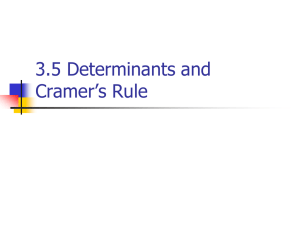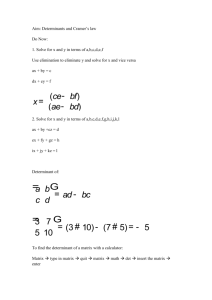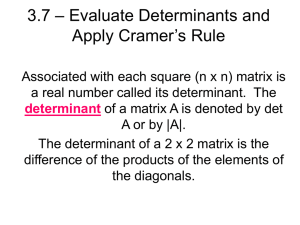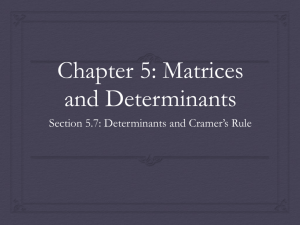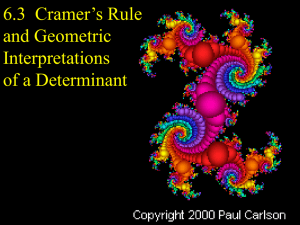4-4
advertisement
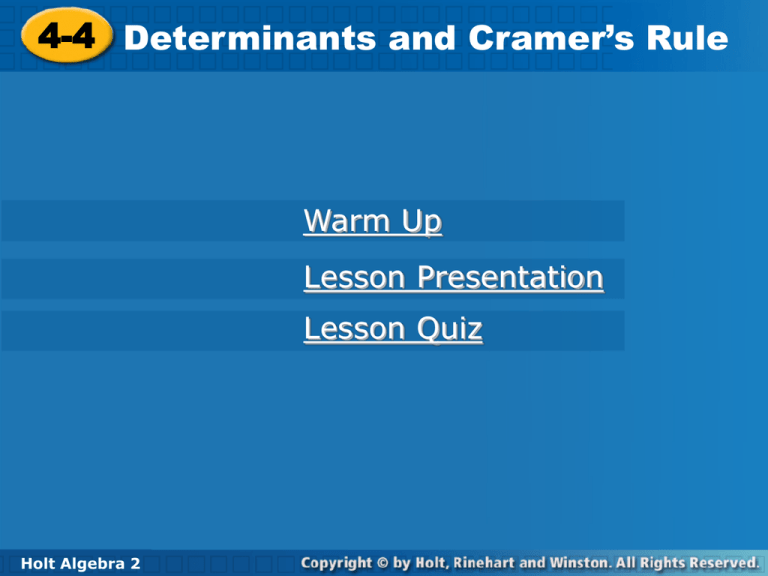
4-4 4-4 Determinants Determinantsand andCramer’s Cramer’sRule Rule Warm Up Lesson Presentation Lesson Quiz Holt Algebra Holt Algebra 22 4-4 Determinants and Cramer’s Rule Warm Up Determine whether each system has zero, one or infinitely many solutions. 1. 3x + y = 15 3x – 2y = 6 2. x + 2y = 18 –2x – 4y = –36 3. 2x + 3y = 35 4x + 6y = 75 Holt Algebra 2 one infinitely many zero 4-4 Determinants and Cramer’s Rule Objectives Find the determinants of 2 2 and 3 3 matrices. Use Cramer’s rule to solve systems of linear equations. Holt Algebra 2 4-4 Determinants and Cramer’s Rule Vocabulary determinant coefficient matrix Cramer’s rule Holt Algebra 2 4-4 Determinants and Cramer’s Rule Every square matrix (n by n) has an associated value called its determinant, shown by straight vertical brackets, such as . The determinant is a useful measure, as you will see later in this lesson. Holt Algebra 2 4-4 Determinants and Cramer’s Rule Reading Math The determinant of Matrix A may be denoted as det A or |A|. Don’t confuse the |A| notation with absolute value notation. Holt Algebra 2 4-4 Determinants and Cramer’s Rule Example 1A: Finding the Determinant of a 2 x 2 Matrix Find the determinant of each matrix. Find the difference of the cross products. = 8 – 20 The determinant is –12. Holt Algebra 2 4-4 Determinants and Cramer’s Rule Example 1B: Finding the Determinant of a 2 x 2 Matrix Find the determinant of each matrix. . =1– Holt Algebra 2 The determinant is . 4-4 Determinants and Cramer’s Rule Check It Out! Example 1a Find the determinant of each matrix. =1+9 The determinant is 10. Holt Algebra 2 4-4 Determinants and Cramer’s Rule Check It Out! Example 1b Find the determinant of each matrix. The determinant is Holt Algebra 2 4-4 Determinants and Cramer’s Rule Check It Out! Example 1c Find the determinant of each matrix. The determinant is Holt Algebra 2 4-4 Determinants and Cramer’s Rule You can use the determinant of a matrix to help you solve a system of equations. For two equations with two variables written in ax + by = c form, you can construct a matrix of the coefficients of the variables. For the system a1x + b1y = c1 a2x + b2y = c2 the coefficient matrix is Holt Algebra 2 4-4 Determinants and Cramer’s Rule The coefficient matrix for a system of linear equations in standard form is the matrix formed by the coefficients for the variables in the equations. The determinant D of the coefficient matrix is Holt Algebra 2 4-4 Determinants and Cramer’s Rule You can use Cramer’s rule to tell whether the system represented by the matrix has one solution, no solution, or infinitely many solutions. Holt Algebra 2 4-4 Determinants and Cramer’s Rule Example 2A: Using Cramer’s Rule for Two Equations Use Cramer’s rule to solve each system of equations. Step 1 Find D, the determinant of the coefficient matrix. D 0, so the system is consistent. Holt Algebra 2 4-4 Determinants and Cramer’s Rule Example 2A Continued Step 2 Solve for each variable by replacing the coefficients of that variable with the constants as shown below. The solution is (4, 2). Holt Algebra 2 4-4 Determinants and Cramer’s Rule Example 2B: Using Cramer’s Rule for Two Equations Use Cramer’s rule to solve each system of equations. Step 1 Write the equations in standard form. Holt Algebra 2 4-4 Determinants and Cramer’s Rule Example 2B Continued Step 2 Find the determinant of the coefficient matrix. D = 0, so the system is either inconsistent or dependent. Check the numerators for x and y to see if either is 0. Since at least one numerator is 0, the system is dependent and has infinitely many solutions. Holt Algebra 2 4-4 Determinants and Cramer’s Rule Check It Out! Example 2 Use Cramer’s rule to solve. Step 1 Write the equations in standard form. Holt Algebra 2 4-4 Determinants and Cramer’s Rule Check It Out! Example 2 Continued Step 2 Find the determinant of the coefficient matrix. D = 0, so the system is either inconsistent or dependent. Check the numerators for x and y to see if either is 0. Because D = 0 and one of the numerator determinants is equal to 0, the system is dependent and has infinitely many solutions. Holt Algebra 2 4-4 Determinants and Cramer’s Rule To apply Cramer’s rule to 3 3 systems, you need to find the determinant of a 3 3 matrix. One method is shown below. Holt Algebra 2 4-4 Determinants and Cramer’s Rule Example 3: Finding the Determinant of a 3 3 Matrix Find the determinant of M. Step 1 Multiply each “down” diagonal and add. 2(2)(8)+ 4(3)(1) + 1(5)(4) = 64 Step 2 Multiply each “up” diagonal and add. 1(2)(1)+ 4(3)(2) + 8(5)(4) = 186 Holt Algebra 2 4-4 Determinants and Cramer’s Rule Example 3 Continued Step 3 Find the difference of the sums. 64 – 186 = –122 The determinant is –122. Check Use a calculator. Holt Algebra 2 4-4 Determinants and Cramer’s Rule Check It Out! Example 3 Find the determinant of Step 1 Multiply each “down” diagonal and add. 2(1)(–1) + (–3)(–2)(10) + 4(5)(3) = 118 Step 2 Multiply each “up” diagonal and add. 10(1)(4) + (3)(–2)(2) – 1(5)(–3) = 43 Holt Algebra 2 4-4 Determinants and Cramer’s Rule Check It Out! Example 3 Continued Step 3 Find the difference of the sums. 118 – 43 = 75 The determinant is 75. Check Use a calculator. Holt Algebra 2 4-4 Determinants and Cramer’s Rule Cramer’s rule can be expanded to cover 3 3 systems. If D ≠ 0, then the system has a unique solution. If D = 0 and no numerator is 0, then the system is inconsistent. If D = 0 and at least one numerator is 0, then the system may be inconsistent or dependent. Holt Algebra 2 4-4 Determinants and Cramer’s Rule Example 4: Nutrition Application A nutritionist creates a diet for a long-distance runner that includes 3400 Calories from 680 grams of food, with half the Calories coming from carbohydrates. How many grams of protein, carbohydrates, and fat will this diet include? Calories per Gram Food Protein Carbohydrates Fat Holt Algebra 2 Calories 4 4 9 The diet will include p grams of protein, c grams of carbohydrates, and f grams of fat. 4-4 Determinants and Cramer’s Rule Example 4 Continued 4p + 4c + 9f = 3400 p + c + f = 680 4c = 1700 Use a calculator. Holt Algebra 2 Equation for total Calories Total grams of food Calories from carbohydrates, 4-4 Determinants and Cramer’s Rule Example 4 Continued p = 119 c = 725 f = 136 The diet includes 119 grams of protein, 425 grams of carbohydrates, and 136 grams of fat. Holt Algebra 2 4-4 Determinants and Cramer’s Rule Check It Out! Example 4 What if...? A diet requires 3200 calories, 700 grams of food, and 70% of the Calories from carbohydrates and fat. How many grams of protein, carbohydrates, and fat does the diet include? Calories per Gram Food Protein Calories 4 Carbohydrates Fat 4 9 Holt Algebra 2 The diet will include p grams of protein, c grams of carbohydrates, and f grams of fat. 4-4 Determinants and Cramer’s Rule Check It Out! Example 4 Continued 4p + 4c + 9f = 3200 p + c + f = 700 4c + 9f = 2240 Use a calculator. Holt Algebra 2 Equation for total Calories Total grams of food Calories from carbohydrates and fat, 70%(3200) = 2240. 4-4 Determinants and Cramer’s Rule Check It Out! Example 4 Continued p = 240 c = 380 f = 80 The diet includes 240 grams of protein, 380 grams of carbohydrates, and 80 grams of fat. Holt Algebra 2 4-4 Determinants and Cramer’s Rule Lesson Quiz Find the determinant of each matrix. 1. 6 2. –34 Use Cramer’s rule to solve. 3. 4. Jeff buys 7 apples and 4 pears for $7.25. At the same prices, Hayley buy 5 apples and 9 pears for $10.40. What is the price of one pear? $0.85 Holt Algebra 2
